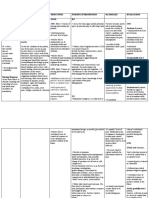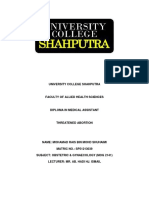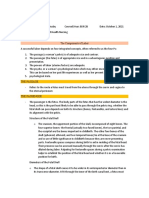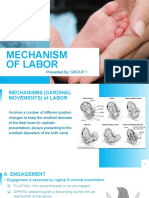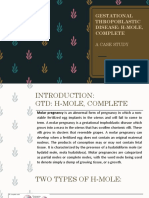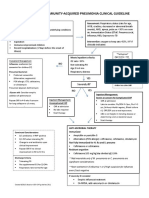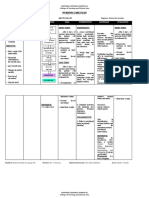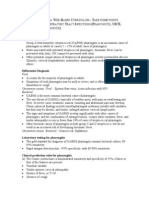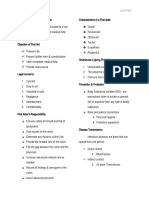Boils and Carbuncles: (Mayo Clinic)
Uploaded by
Jimmy ThomasBoils and Carbuncles: (Mayo Clinic)
Uploaded by
Jimmy ThomasBoils and carbuncles (Mayo Clinic)
Overview
Boils and carbuncles are painful, pus-filled bumps that form under your skin when bacteria infect and inflame one or more of your hair
follicles.
Boils (furuncles) usually start as red, tender lumps. The lumps quickly fill with pus, growing larger and more painful until they rupture and
drain. A carbuncle is a cluster of boils that form a connected area of infection under the skin.
You can usually care for a single boil at home. But don't attempt to prick or squeeze it — that may spread the infection.
Symptoms
Boils
Boils can occur anywhere on your skin, but appear mainly on your face, neck, armpits, buttocks or thighs — hair-bearing areas where you're
most likely to sweat or experience friction. Signs and symptoms of a boil usually include:
A painful, red bump that starts out about the size of a pea
Red, swollen skin around the bump
An increase in the size of the bump over a few days as it fills with pus (can sometimes reach the size of a baseball)
Development of a yellow-white tip that eventually ruptures and allows the pus to drain out
Carbuncles
A carbuncle is a cluster of boils that form a connected area of infection. Carbuncles often occur on the back of the neck, shoulders or thighs.
Compared with single boils, carbuncles cause a deeper and more severe infection and are more likely to leave a scar. People who have a
carbuncle often feel unwell in general and may experience a fever and chills.
When to see a doctor
You usually can care for a single, small boil yourself. But see your doctor if you have more than one boil at a time or if a boil:
Occurs on your face
Worsens rapidly or is extremely painful
Causes a fever
Is more than 2 inches (5 centimeters) across
Hasn't healed in two weeks
Recurs
Causes
Most boils are caused by Staphylococcus aureus, a type of bacteria commonly found on the skin and inside the nose. Boils sometimes
develop at sites where the skin has been broken by a small injury or an insect bite, which gives the bacteria easy entry.
Risk factors
Although anyone — including otherwise healthy people — can develop boils or carbuncles, the following factors can increase your risk:
Close contact with a person who has a staph infection. You're more likely to develop an infection if you live with someone who
has a boil or carbuncle.
Diabetes. This disease can make it more difficult for your body to fight infection, including bacterial infections of your skin.
Other skin conditions. Because they damage your skin's protective barrier, skin problems, such as acne and eczema, make you
more susceptible to boils and carbuncles.
Compromised immunity. If your immune system is weakened for any reason, you're more susceptible to boils and carbuncles.
Complications
Rarely, bacteria from a boil or carbuncle can enter your bloodstream and travel to other parts of your body. The spreading infection,
commonly known as blood poisoning (sepsis), can lead to infections deep within your body, such as your heart (endocarditis) and bone
(osteomyelitis).
Prevention
It's not always possible to prevent boils, especially if you have a weakened immune system. But the following measures may help you avoid
staph infections:
Wash your hands regularly with mild soap. Or use an alcohol-based hand rub often. Careful hand-washing is your best
defense against germs.
Keep wounds covered. Keep cuts and abrasions clean and covered with sterile, dry bandages until they heal.
Keep personal items personal. Avoid sharing personal items, such as towels, sheets, razors, clothing and athletic equipment.
Staph infections can spread via objects, as well as from person to person. If you have a cut or sore, wash your towels and linens using
detergent and hot water with added bleach, and dry them in a hot dryer.
Diagnosis
Your doctor will likely be able to diagnose a boil or carbuncle simply by looking at it. He or she might suggest sending a sample of the pus to
a lab for testing. This may be useful if you have recurring infections or an infection that hasn't responded to standard treatment.
Many varieties of the bacteria that cause boils have become resistant to certain types of antibiotics. So lab testing can help determine what
type of antibiotic would work best in your situation.
Treatment
You can generally treat small boils at home by applying warm compresses to relieve pain and promote natural drainage.
For larger boils and carbuncles, treatment may include:
Incision and drainage. Your doctor may drain a large boil or carbuncle by making a small incision in the tip. Deep infections that
can't be completely drained may be packed with sterile gauze to help soak up and remove additional pus.
Antibiotics. Sometimes your doctor may prescribe antibiotics to help heal severe or recurrent infections.
BOILS (webmd)
A boil is a skin infection that starts in a hair follicle or oil gland. At first, the skin turns red in the area of the infection, and a tender lump develops.
After four to seven days, the lump starts turning white as pus collects under the skin.
The most common places for boils to appear are on the face, neck, armpits, shoulders, and buttocks. When one forms on the eyelid, it
is called a sty.
If several boils appear in a group, this is a more serious type of infection called a carbuncle.
Causes of Boils
Most boils are caused by a germ (staphylococcal bacteria). This germ enters the body through tiny nicks or cuts in the skin or can travel down
the hair to the follicle.
These health problems make people more susceptible to skin infections:
Diabetes
Problems with the immune system
Poor nutrition
Poor hygiene
Exposure to harsh chemicals that irritate the skin
Symptoms of Boils
A boil starts as a hard, red, painful lump usually about half an inch in size. Over the next few days, the lump becomes softer, larger, and more
painful. Soon a pocket of pus forms on the top of the boil. These are the signs of a severe infection:
The skin around the boil becomes infected. It turns red, painful, warm, and swollen.
More boils may appear around the original one.
A fever may develop.
Lymph nodes may become swollen.
When to Seek Medical Care
You start running a fever.
You have swollen lymph nodes.
The skin around the boil turns red or red streaks appear.
The pain becomes severe.
The boil does not drain.
A second boil appears.
You have a heart murmur, diabetes, any problem with your immune system, or use immune suppressing drugs (for example,
corticosteroids or chemotherapy) and you develop a boil.
Boils usually do not need immediate emergency attention. However, if you are in poor health and you develop high fever and
chills along with the infection, a trip to a hospital's emergency room is needed.
Exams and Tests
Your doctor can make the diagnosis with a physical exam. Many parts of the body may be affected by this skin infection, so some of the
questions or exam may be about other parts of your body.
Boils Treatment -- Home Remedies
Apply warm compresses and soak the boil in warm water. This will decrease the pain and help draw the pus to the surface. Once the
boil comes to a head, it will burst with repeated soakings. This usually occurs within 10 days of its appearance. You can make a warm
compress by soaking a wash cloth in warm water and squeezing out the excess moisture.
When the boil starts draining, wash it with an antibacterial soap until all the pus is gone and clean with rubbing alcohol. Apply a
medicated ointment (topical antibiotic) and a bandage. Continue to wash the infected area two to three times a day and to use warm
compresses until the wound heals.
Do not pop the boil with a needle. This could make the infection worse.
Medical Treatment for Boils
If there are concerns about the seriousness of the infection, additional blood tests will be performed. The doctor may prescribe antibiotics if the
infection is severe. If the boil is drained, a culture may be done to determine the type of bacteria causing the infection and to assess if an
appropriate antibiotic was given.
Next Steps -- Follow-up
Whether the boil is drained at home or is lanced by a doctor, you will need to clean the infected area two to three times a day until the wound is
healed. Apply an antibiotic ointment after washing and cover with a bandage. If the area turns red or looks as if it is getting infected again, contact
your doctor.
Preventing Boils
Help prevent boils by following these guidelines:
Carefully wash clothes, bedding, and towels of a family member who is infected with boils.
Clean and treat minor skin wounds.
Practice good personal hygiene.
Stay as healthy as possible.
Outlook
Most boils will disappear with simple home treatment.
BOILS & CARBUNCLES (National Health Service)
Boils
Boils can develop anywhere on your skin, but you're most likely to get one in an area where there's a combination of hair,
sweat and friction, such as the neck, face or thighs.
Over time, pus forms inside the boil, making it bigger and more painful. Most boils eventually burst and the pus drains
away without leaving a scar. This can take from two days to three weeks to happen.
It can sometimes be difficult to tell the difference between a boil and a spot, but boils tend to grow bigger and become
more painful. Your GP should be able to diagnose a boil from its appearance.
Carbuncles
A carbuncle is a dome-shaped cluster of boils that usually develops over a few days. The areas most commonly affected
are the back, thighs, or back of the neck.
A carbuncle can grow to a size of 3-10cm and will leak pus from a number of points.
You may also:
have a high temperature of 38C (100.4F) or above
feel generally unwell
feel weak and exhausted
Carbuncles are less common than boils and tend to mostly affect middle-aged or older men in poor health or with a
weakened immune system.
When to see your GP
See your GP if you think you have a carbuncle.
With boils, you don't usually need to see a doctor as most boils burst and heal by themselves. But see your GP if you have
a boil:
on your face, nose or spine – this can sometimes cause serious complications
that gets bigger and feels soft and spongy to touch – it may not burst and heal by itself
that doesn't heal within two weeks
and you have a temperature and feel generally unwell
Your GP should be able to identify a boil or carbuncle by looking at it.
Further testing
Further testing, such as a blood test or skin swab, may be needed if you have:
a boil or carbuncle that keeps returning or doesn't respond to treatment
multiple boils or carbuncles
a weakened immune system caused by a condition such as diabetes, or having a treatment such as chemotherapy
Treating boils and carbuncles
Self care
Most boils get better without the need for medical treatment.
One of the best ways to speed up healing is to apply a warm, moist face cloth to the boil for 10-20 minutes, three or four
times a day.
The heat increases the amount of blood circulating around the boil, which sends more infection-fighting white blood cells
to the area.
When the boil bursts, cover it with sterile gauze or a dressing to prevent the spread of infection. Afterwards, wash your
hands thoroughly using hot water and soap.
Never squeeze or pierce a boil because it could spread the infection.
You can use over-the-counter painkillers, such as paracetamol or ibuprofen, to help relieve any pain caused by the boil.
Draining boils
If your boil doesn't heal, your GP may decide to drain it, or refer you to hospital to have this done. They'll usually numb
the area first and then use a sterile needle or scalpel to pierce the boil.
Antibiotics
Antibiotics are usually recommended:
for all cases of carbuncles
if you have a high temperature
if you develop a secondary infection, such as cellulitis (infection of the deeper layers of the skin)
if you have a boil on your face – facial boils have a higher risk of causing complications
if you're in severe pain and discomfort
It's very important to finish the course of antibiotics even if the boil goes away, otherwise the infection could return.
Treating recurrent boils and carbuncles
You're likely to need further treatment if you keep getting boils or carbuncles.
Most people who keep getting boils are carriers of Staphylococcus aureus (staph bacteria). This means they have staph
bacteria living on their skin or inside their nose.
Treatment will depend on where the bacteria are found on your body. An antiseptic soap can be used to kill the bacteria on
the skin. Bacteria in the nose will need to be treated with a prescribed antiseptic cream for up to 10 days.
Causes of boils and carbuncles
Boils and carbuncles are often caused by a type of bacteria called Staphylococcus aureus (staph bacteria) that infects one
or more hair follicles. Staph bacteria usually live harmlessly on the surface of the skin or in the lining of the nose.
You can get a boil when bacteria enter the skin through cuts and grazes. Your immune system responds by sending
infection-fighting white blood cells to kill the bacteria.
Over time, a mixture of dead bacteria, dead white blood cells and dead skin cells builds up inside the boil to form pus.
A carbuncle develops when the infection spreads further beneath the skin to create a cluster of boils.
Complications of boils and carbuncles
Although most boils and carbuncles don't cause further problems, some people develop a secondary infection.
This can range from a relatively minor (though often very painful) infection of the deeper layer of the skin, such
as cellulitis, to rarer and more serious complications, such as sepsis.
Larger boils and carbuncles can also lead to scarring.
Preventing boils and carbuncles
You can't always avoid getting a boil or carbuncle, but these simple steps can reduce your risk:
wash your skin regularly using a mild antibacterial soap
carefully clean any cuts, wounds or grazes (even small ones)
cover cuts, wounds and grazes with a sterile bandage until they heal
eat healthily and exercise regularly to boost your immune system
Can I catch a boil or carbuncle?
Yes, you can. Unlike acne, boils and carbuncles can spread to another part of the body or to another person.
To prevent boils and carbuncles spreading, take simple precautions such as:
washing your hands after touching affected areas
using a separate face cloth and towel
washing underwear, bed linen and towels at a high temperature
covering wounds with a dressing until they heal
carefully disposing of used dressings
Armpit boils (https://www.embarrassingproblems.com/problem/armpit-boils)
Armpit boils can be caused by a condition called ‘hidradenitis suppurativa’, which
affects about 1-4% of the population. In fact, if you’ve had boils in your armpit on
more than five occasions, it is very likely to be hidradenitis. Typically, if you have
hidradenitis you will develop about two painful boils a month, each of which takes
about a week to go away, although some people are more badly affected. In really
severe cases, boils may be present all the time.
Hidradenitis is not primarily an infection, so you cannot pass it on to anyone else
and you will not spread it to other parts of your own body by touch.
What causes hidradenitis?
Hidradenitis is caused by blockage of the hair follicles. Once blocked, the hair
follicle becomes inflamed and swells up into a nasty, painful, large boil. Bacteria
may move in and make the inflammation worse. These are just the common
staphylococci bacteria that many healthy people carry on their skin or in their
noses.
Hidradenitis happens only in the folds of the body – almost always the armpits or
groins, but sometimes the buttock folds and under the breasts. The boils do not
always burst; they may just fade away.
You should not worry that it is caused by lack of hygiene – this is not the case. No
one knows what the cause is. It runs in some families, so it may be partly genetic
in some people. Hormones may be involved, because it is more common in
women, is often worse before a woman’s period and improves after the
menopause.
What to do
Try to avoid too much stress, although of course this is easier said than done. You
may have already noticed that the boils tend to be worse if you are stressed, so it
makes sense to be as ‘laid back’ as you can.
Stop smoking. Hidradenitis is more common in smokers, so most experts
recommend that you should give up smoking.
What about deodorants?I didn’t know whether deodorants can worsen
hidradenitis, so I asked Dr Jan von der Werth, Consultant Dermatologist at Lincoln
County Hospital, UK, who is an expert on hidradenitis. "A few of my patients
report that deodorants make it worse, but for most people they don’t cause any
problem," he said.
If you have a flare-up you may find that a hot bath or applying a hot flannel is
helpful.
See your doctor.Next time you have a flare-up you should see your doctor, to
check you really have hidradenitis. If it is very painful, your doctor might give you
corticosteroid tablets for 3 or 4 days. Lancing the boil is not a good idea, because
it often makes the condition worse. And a short course of antibiotics doesn’t
usually help.
Your doctor can refer you to a dermatologist (skin specialist) for advice about
long-term treatment. Ideally, your doctor should try to find a dermatologist who
is particularly interested in the condition and knows all the treatment options.
Some treatment options.There are several possibilities, and what works for one
person may be useless for someone else.
A hormone pill is sometimes used.
For some people, a long-term tetracycline-type or erythromycin-type
antibiotic is beneficial, or a clindamycin cream, even though the basic cause of the
condition is not an infection. "We don’t really know why these long-term
antibiotics are so helpful in some cases," says Dr von der Werth. "It is probably
not simply their antibacterial action. They probably have a separate anti-
inflammatory action." After stopping an antibiotic, the problem may return so it is
not an absolute cure - it just holds it at bay.
Retinoid drugs (as used in acne) can have an excellent result, but need very
careful thought. The dermatologist would not prescribe it for a woman if there
was any possibility that she could become pregnant because it damages the
developing foetus.
‘Anti-TNF drugs’, such as infliximab, can help some people. These are a
newish type of drug, sometimes used in severe skin conditions where there is
inflammation. The treatment is complicated, because the drug has to be infused
into a vein and repeated every month or two (MIMS Dermatology 2010;6(3):46-
8). Therefore it would be tried only in severe cases, and more research is needed
to see how effective it really is.
Surgery is an option if your condition is really severe. The surgeon would
aim to get rid of the hair follicles in the area by taking away a large piece of skin
and letting it scar as it heals. Unfortunately, after surgery the boils reappear at a
new site in about a quarter of people (MIMS Dermatology 2010;6(3):46-8).
Laser surgery or freezing (cryotherapy) therapy is another method of
destroying the follicles.
Written by: Margaret Stearn
Edited by: Margaret Stearn
Last updated: Friday, December 2nd 2011
What Are the Causes of Armpit Boils?
by VITAI Last Updated: Aug 14, 2017
Armpit boils arise from an infection of the hair follicle under the arm. The
infection creates large lesions that form under the armpit and are usually filled
with a clear fluid called pus. The infected area may become red and inflamed; it
may also easily become irritated when clothes rub across the surface. Individuals
experiencing armpit boils may feel pain and discomfort under the arms. The
infection at the source of armpit boils may arise from multiple causes.
Poor Hygiene
Poor hygiene can cause armpit boils because of the dirt that is trapped within the
hair follicle. Failure to bathe regularly can cause excess dirt, sweat and bacteria to
collect under the armpit, causing a painful boil to appear. The boil may be either
red or dark in color and is usually sensitive to the touch. According to the Better
Health Channel, armpit boils may occur due to buildup of dead skin cells and
bacteria on the skin under the arm. If an opening such as a cut is present on the
surface of the skin, bacteria may enter and form boils.
Ingrown Hairs
Armpit boils in women may occur as a result of excessive underarm shaving,
which can lead to an ingrown hair under the arm. The hair will grow under the
surface of the skin and form a large boil as a result. According to New York
University Langone Medical Center, the boil will soften with time, which can cause
a large pus-filled head to form at the top of the boil. A doctor should be notified
of the condition if it is accompanied by a fever. Boils can also be contagious if
popped or allowed to drain.
Staph Infection
Staph bacteria are present on the skin's surface and can be found in the nose,
armpits or other warm creases of the skin. If a Staph bacterium enters an open
sore, it can cause a boil. According to Hope College Health Center, boils may occur
as a result of a Staph infection developing around the armpit and usually heal on
their own. Staph infections are most common in areas that are covered with body
hair, which makes the armpit an ideal place for the bacteria to dwell.
Treatment for boil under armpit
If you have developed painful boils or cysts under your arms, then it is possible
you have the condition known as hidradenitis suppurativa, or acne inversa. This is
a condition that affects the skin, and the first symptom will usually be the onset of
boils, either in the armpit or the groin area.
The boils will develop here because these regions are warm, moist and contain
large numbers of hair follicles. The boils occur when the apocrine sweat glands
become blocked and pus begins to form in the hair follicles and the tubes leading
from the sweat glands to the skin. Once the pus has started to form, it may leak
onto the surface of the skin, and then the second noticeable symptom will begin
to develop. The bacteria that are naturally present on the skin will start to act on
the pus, breaking it down and leading to the onset of the distinctive smell that is
associated with hidradenitis suppurativa.
To read testimonials and get the Fast Hidradenitis Suppurativa Cure e-book
click here.
success
There are several possible treatments for the underarm boils of hidradenitis
suppurativa, and you may wish to try several before finding one that is the most
effective for you. Many hidradenitis suppurativa patients opt to use natural
methods of controlling the symptoms, which are often more effective on a long
term basis than antibiotics. The problem with using antibiotics is that the bacteria
on your skin will become resistant to them, making it even more difficult to treat
the condition in the future. Stronger antibiotics would need to be used, normally
in conjunction with other medications such as corticosteroids, which will help to
reduce the swelling, but can only be used on a short term basis.
Instead of becoming reliant on these medications, an increasing number of acne
inversa patients are instead choosing to treat their condition using a combination
of natural remedies and modifications to the diet. There are a number of natural
remedies that can be applied topically to the boils under your arms, and when the
treatment is used on a regular basis, you should start to notice improvements
rapidly.
The abscesses and cysts should soon decrease in size, which will relieve some of
the pressure under the skin and reduce the pain that you experience. It will also
encourage healing of the abscesses and reduce the extent of their spread – this is
of particular interest to those patients with severe forms of the disease, where
the cysts will have begun to spread to other areas of the body. Cysts that have
begun under the arms will spread to parts of the chest and back.
If you suffer from boils under the arm as a result of hidradenitis suppurativa, then
there are a number of methods that you could try in order to manage your
condition more effectively. Wash the affected areas with an antiseptic substance
– you can either buy an antiseptic solution or make up a dilution of tea tree oil.
This will help to reduce the number of bacteria in the area.
If you have large abscesses or sinus tracts that leak pus, then it might be a good
idea to try to encourage these to drain at a time you choose, which could
minimise leakage throughout the day. Hold a warm cloth over the boils to
encourage the pus to drain out. Once the pus has started to flow out, the
pressure and the pain will be reduced.
After this, it would be advisable to use a substance such as aloe vera to promote
healing of these areas. Aloe vera has been used for thousands of years to prevent
infection and encourage healing, and the reason it is so popular is because it is
effective.
You might also like
- "My Breasts Are Sore and Tender But There Is No Milk Coming Out and Im Also in Pain Due To Uterine CrampingNo ratings yet"My Breasts Are Sore and Tender But There Is No Milk Coming Out and Im Also in Pain Due To Uterine Cramping3 pages
- Communicable Disease: - East Africa University Bosaso, Puntland Somalia Mr. Buruj AliNo ratings yetCommunicable Disease: - East Africa University Bosaso, Puntland Somalia Mr. Buruj Ali38 pages
- Pitting and Non-Pitting Oedema: Clinical SkillsNo ratings yetPitting and Non-Pitting Oedema: Clinical Skills3 pages
- BCG Vaccine: Serum Institute of India Pvt. LTDNo ratings yetBCG Vaccine: Serum Institute of India Pvt. LTD1 page
- Integumentary Disoder: Nursing Care PlanNo ratings yetIntegumentary Disoder: Nursing Care Plan3 pages
- Case Study Myoma 150904183220 Lva1 App6892100% (1)Case Study Myoma 150904183220 Lva1 App689255 pages
- (NCP) Activity Intolerance, Spiritual Distress, Disturbed Sleep Pattern0% (1)(NCP) Activity Intolerance, Spiritual Distress, Disturbed Sleep Pattern12 pages
- Summary Product Charecteristics: Rabies Vaccine For Human Use, (Vero-Cell) Freeze-Dried (Speeda Vaccine)No ratings yetSummary Product Charecteristics: Rabies Vaccine For Human Use, (Vero-Cell) Freeze-Dried (Speeda Vaccine)4 pages
- Pediatric Community-Acquired Pneumonia Clinical Guideline PDFNo ratings yetPediatric Community-Acquired Pneumonia Clinical Guideline PDF1 page
- Stages of Labor Nursing Intervention: First StageNo ratings yetStages of Labor Nursing Intervention: First Stage3 pages
- Prevalence of Teenage Pregnancy Among Pregnant Mothers Presenting at Hoima Regional Referral Hospital During The Covid-19 Pandemic (2020 To 2021)No ratings yetPrevalence of Teenage Pregnancy Among Pregnant Mothers Presenting at Hoima Regional Referral Hospital During The Covid-19 Pandemic (2020 To 2021)8 pages
- Preeclampsia Pathophysiology and ManagementNo ratings yetPreeclampsia Pathophysiology and Management7 pages
- C C W - B C - T M: U R T I (P, Urti, S, B) : (1) PharyngitisNo ratings yetC C W - B C - T M: U R T I (P, Urti, S, B) : (1) Pharyngitis5 pages
- Vaccine Preventable Communicable DiseasesNo ratings yetVaccine Preventable Communicable Diseases7 pages
- Source: Operating Room Technique by Nancymarie PhillipsNo ratings yetSource: Operating Room Technique by Nancymarie Phillips1 page
- Hyperthyroidism Pathophysiology and Schematic DiagramNo ratings yetHyperthyroidism Pathophysiology and Schematic Diagram1 page
- BBC - Ethics - Euthanasia - Anti-Euthanasia Arguments PDFNo ratings yetBBC - Ethics - Euthanasia - Anti-Euthanasia Arguments PDF9 pages
- Videbeck CH 1 Foundations of Psych Mental HealthNo ratings yetVidebeck CH 1 Foundations of Psych Mental Health2 pages
- A Study of the Lack of Hiv/Aids Awareness Among African American Women: a Leadership Perspective: Awareness That All Cultures Should Know AboutFrom EverandA Study of the Lack of Hiv/Aids Awareness Among African American Women: a Leadership Perspective: Awareness That All Cultures Should Know About5/5 (1)
- Cyanosis, A Simple Guide To The Condition, Diagnosis, Treatment And Related ConditionsFrom EverandCyanosis, A Simple Guide To The Condition, Diagnosis, Treatment And Related Conditions5/5 (1)
- Hydrocele, A Simple Guide To The Condition, Diagnosis, Treatment And Related ConditionsFrom EverandHydrocele, A Simple Guide To The Condition, Diagnosis, Treatment And Related ConditionsNo ratings yet
- Leishmaniasis, A Simple Guide To The Condition, Diagnosis, Treatment And Related ConditionsFrom EverandLeishmaniasis, A Simple Guide To The Condition, Diagnosis, Treatment And Related ConditionsNo ratings yet
- Air Pollution: From Wikipedia, The Free EncyclopediaNo ratings yetAir Pollution: From Wikipedia, The Free Encyclopedia54 pages
- The Championships: Wimbledon, or Simply Wimbledon, Is The OldestNo ratings yetThe Championships: Wimbledon, or Simply Wimbledon, Is The Oldest10 pages
- Unesco - Eolss Sample Chapters: History of RheologyNo ratings yetUnesco - Eolss Sample Chapters: History of Rheology8 pages
- Corporate Presentation: Coastland Geotechnics LLPNo ratings yetCorporate Presentation: Coastland Geotechnics LLP12 pages
- Gumbo Clay and What It Does To Your House.: Ask Jon EakesNo ratings yetGumbo Clay and What It Does To Your House.: Ask Jon Eakes1 page
- Classification and Management of Open Fractures: DR Ramachandran MS., Dept of Orthopedics, SMS Medical CollegeNo ratings yetClassification and Management of Open Fractures: DR Ramachandran MS., Dept of Orthopedics, SMS Medical College35 pages
- (Amaleaks - Blogspot.com) Eapp-111 Week 20 Second Quarter Exam0% (1)(Amaleaks - Blogspot.com) Eapp-111 Week 20 Second Quarter Exam35 pages
- Rle Rotation 5 Simulated Clinical ExperienceNo ratings yetRle Rotation 5 Simulated Clinical Experience5 pages
- Management of a Trauma Patient- Oral SurgeryNo ratings yetManagement of a Trauma Patient- Oral Surgery27 pages
- (Ebooks PDF) Download (Ebook PDF) Essential Procedures For Emergency, Urgent, and Primary Care Settings: A Clinical Companion Full Chapters100% (4)(Ebooks PDF) Download (Ebook PDF) Essential Procedures For Emergency, Urgent, and Primary Care Settings: A Clinical Companion Full Chapters49 pages
- Mine Accident, Injury and Illness Report: Pproved 1/31/2021 OMB No. 1219-0007No ratings yetMine Accident, Injury and Illness Report: Pproved 1/31/2021 OMB No. 1219-00075 pages
- Wound Care and Laceration Repair For Nurse Practitioners in Emergency CareNo ratings yetWound Care and Laceration Repair For Nurse Practitioners in Emergency Care2 pages
- Challenges of Venous Leg Ulcer Management: Definition and AetiologyNo ratings yetChallenges of Venous Leg Ulcer Management: Definition and Aetiology6 pages
- The Veterinary Care of The Horse 3rd Edition Sue Devereux 2024 Scribd DownloadNo ratings yetThe Veterinary Care of The Horse 3rd Edition Sue Devereux 2024 Scribd Download34 pages
- Leg Ulcer Infection Antimicrobial Prescribing PDF 66141836924101No ratings yetLeg Ulcer Infection Antimicrobial Prescribing PDF 6614183692410130 pages
